Red herrings, skateboards, and Carrie Fisher: An oral history of mystery classic Clue
- Oops!Something went wrong.Please try again later.
- Oops!Something went wrong.Please try again later.
- Oops!Something went wrong.Please try again later.
It was Jonathan Lynn on the soundstage with the camera…
So might go the whodunnit response to the man responsible for writing and directing Clue, the 1985 cinematic rendering of the beloved board game. It brings together the classic settings (library, conservatory, billiard room, and so forth) and weapons (revolver, lead pipe, candlestick, etc.) with Miss Scarlet (Lesley Ann Warren), Mrs. White (Madeline Kahn), Mrs. Peacock (Eileen Brennan), Professor Plum (Christopher Lloyd), Mr. Green (Michael McKean), and Colonel Mustard (Martin Mull).
Tim Curry stars as Wadsworth, a mysterious butler who oversees the proceedings of a dinner party that brings together this disparate pack of suspects, all there under colorful aliases, and sets them loose in a mansion where murder and mayhem are afoot as they seek to answer the eternal question: Who killed Mr. Boddy (Lee Ving)?
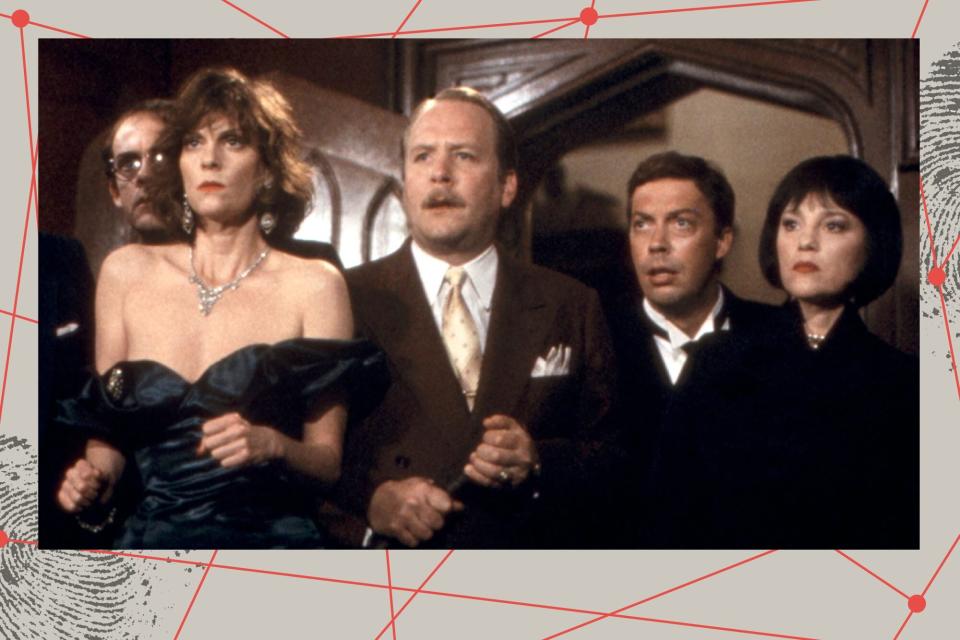
Everett Collection Michael McKean, Christopher Lloyd, Lesley Ann Warren, Martin Mull, Tim Curry, and Madeline Kahn in 'Clue'
Now, in celebration of our first-ever Whodunnit Week, EW does a little sleuthing of our own, diving into the making of the farce and how a classic board game birthed a showcase for one of the best comedic ensembles ever assembled. Take the secret passageway from the conservatory to the lounge, and get ready to put together the clues to uncover how a box office bust became a cult classic.
By the time Jonathan Lynn — writer of series Yes, Minister, and celebrated British theater director — was approached to write a screenplay for a film based on the Clue board game, John Landis (Animal House) was attached to direct. Landis had already approached several screenwriters, including the duo of Stephen Sondheim and Anthony Perkins, who had co-written 1970s whodunnit The Last of Sheila.
JONATHAN LYNN (WRITER/DIRECTOR): I thought it would be nice to meet John Landis, and I'd never been to L.A., so I said yes. John pitched it very excitably, running around his office and playing all the characters at once. Eventually he said, "Then the butler says, 'I know who did it.'" So I said, "Well, who did it?" And John said, "I don't know. That's why I need you to write it." I was the sixth writer. They'd hired several who had given up and returned the money. At one time, they'd hired Tom Stoppard.
But I couldn't really see what to do because it's a board game. Clue didn't have any characters. It had six colors, six weapons, and nine rooms, but no story and no solutions to the story. I felt it was a bit of a straitjacket. But I had a think overnight and came up with a couple of ideas and John asked me to write it. Later, John said he couldn't direct it because he was going to direct another film, and would I like to direct it? I said yes because how often are you offered your first film?
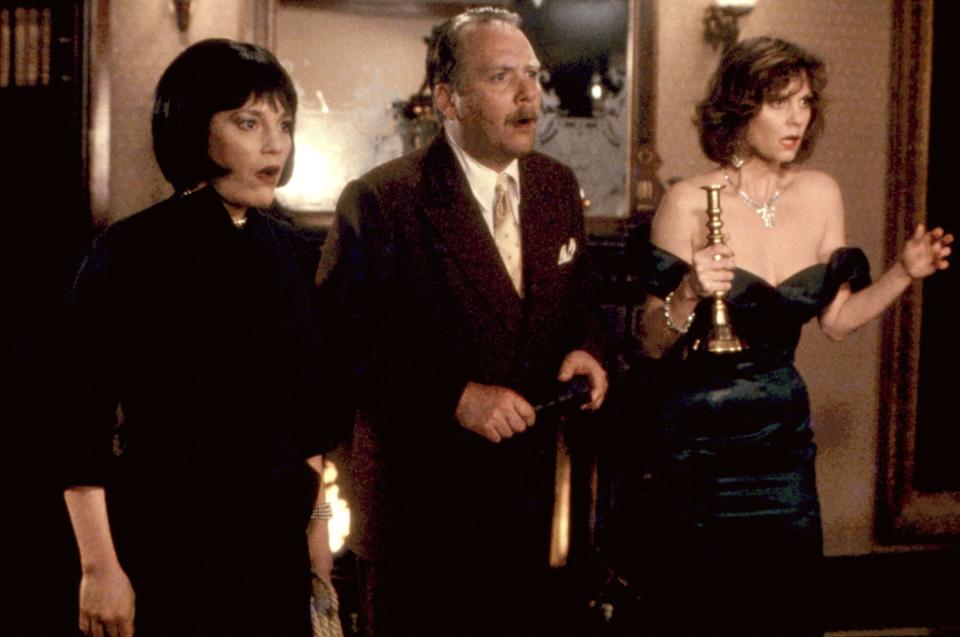
Everett Collection Madeline Kahn, Martin Mull, and Lesley Ann Warren in 'Clue'
Once attached as writer and director, Lynn set about casting the film.
LYNN: Carrie Fisher was originally cast as Miss Scarlet. She was extremely funny. I had heard that she had a drug problem, but I didn't really see any sign of it. Not that I would've known. But she sniffed a lot, and she said she had hay fever. Then a week before we started shooting, I got a phone call from her saying, "I've just gone into rehab. I'll be sleeping here. I'll come out every day and shoot." But the studio told the insurance company, who put a stop to that immediately.
LESLEY ANN WARREN (MISS SCARLET): I was in Greece with my family, and we were all having a wonderful vacation. I got the call about it, and they told me that Carrie had originally been scheduled to do this. I was friends with Carrie at the time and knew what was going on with her. I was very sorry that she was not able to do it, but I was excited and jumped in.
COLLEEN CAMP (YVETTE): From what I understand, a number of people wanted the part, like Julianne Moore and Madonna. But Jennifer Jason Leigh was the choice, and when she did not do the movie, my manager [whom I shared with Jennifer] suggested me. And I went full out — I dressed up in a maid's outfit; I created this French accent. I basically got the part in the room.
LYNN: I chose the people who I thought were right for the parts that made me laugh. I didn't know who most of them were. I didn't know they were famous. I'd seen Christopher Lloyd in Taxi. I'd seen Madeline Kahn in many films, and I was thrilled that she wanted to be in it. But Tim Curry I knew from my school days. We'd known each other since he was 12 and I was 14. He always said he became an actor because I became an actor. Nobody else in our school ever become an actor.
From there, the cast began a period of several weeks of rehearsal to establish the fast pace and intricate choreography of the farce.
LYNN: I understood how fast it had to go. On the first day of rehearsal I showed the cast Howard Hawks' His Girl Friday, which goes at a colossal speed. I said, "That's what we're aiming for. What we're doing here is screwball noir."
CAMP: He was very adamant about the pace. He wanted us to have the rhythm. We would be almost overlapping dialogue. There'd be a certain style to it. So, we all went to Paramount and when His Girl Friday ended, Eileen Brennan said, "You can tell this was before method acting. The people just talk."
MICHAEL MCKEAN (MR. GREEN): We were on the same page as to the level of farce we were doing. Comedy is comedy, but farce is what happens on the worst day of your life.
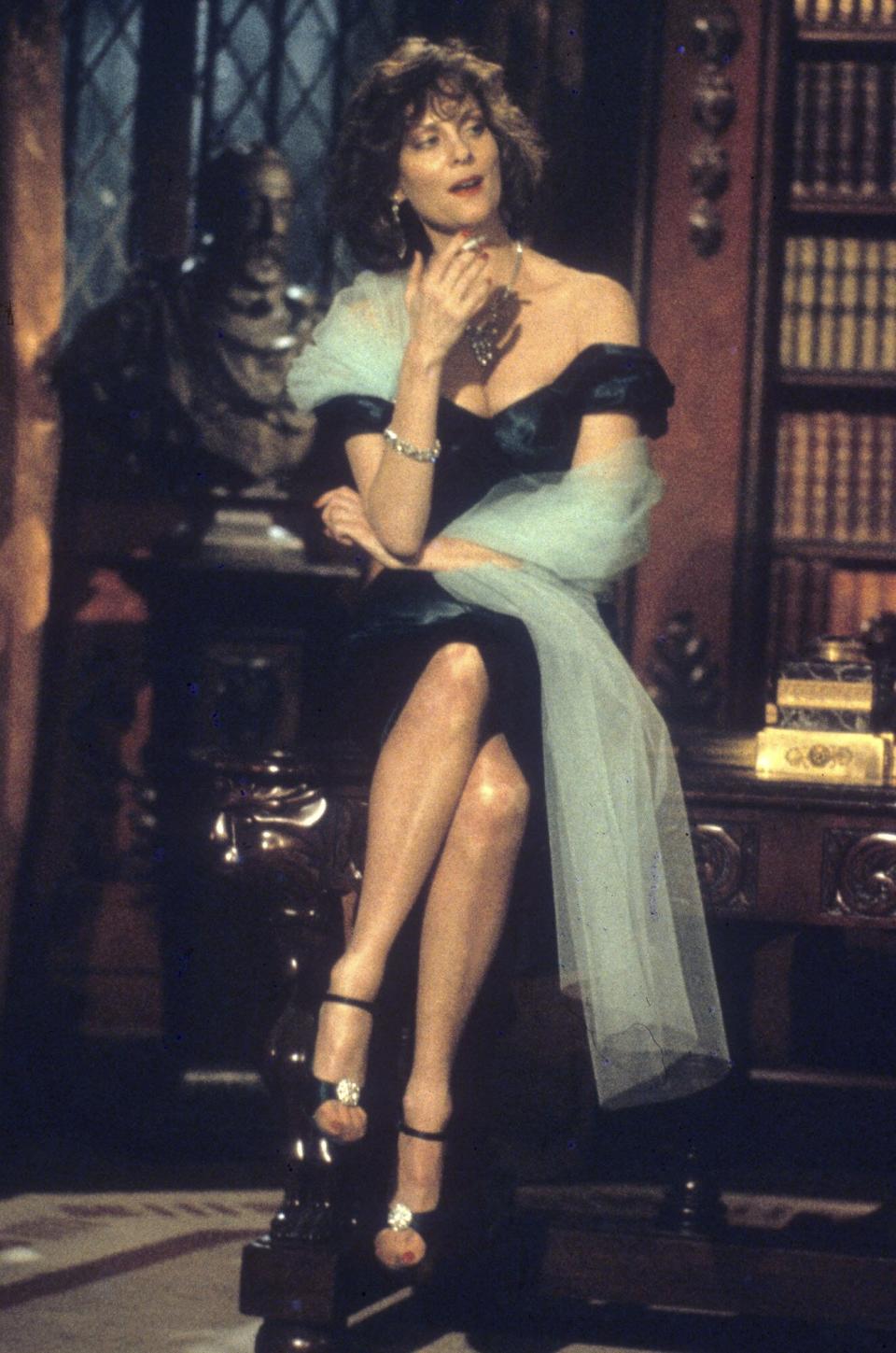
Everett Collection Lesley Ann Warren in 'Clue'
Although the board game features character cards where they sport the color of their name, Jonathan Lynn needed to work out a reason for people to be named after colors — and how they would costume them.
LYNN: There's no reason why a bunch of people would be called Green, Plum, Mustard — it's absurd. So they had to be given aliases, and that meant they all had something to hide. Obviously, somebody who had invited them was blackmailing them. That's how the story got going in my head. What we did discuss and felt very strongly about was that none of them should be dressed in a color that was the same as the name they had. The reason for that was that they didn't know what their alias was, so they wouldn't have come dressed as a color. So, for instance, Miss Scarlet was dressed in green.
WARREN: I loved that dress. It was gorgeous. It looked like it was always going to fall off, and it was so constructed that I felt completely safe that it would never do that. Michael Kaplan also designed the undergarments, and I was wearing a real corset to give it that hourglass shape. But I loved wearing it because it was so specific to her character and made me feel like her. When I got into the dress and the whole nine yards, I had this sense of her being this very in charge, sexy, naughty woman who was powerful in her world.
CAMP: There were three costumes, and I'm heartsick that I didn't take one home. [Laughs]
Except for exteriors and a few interior shots, the entire film was shot on soundstages at Paramount, which made it possible for them to shoot the vast majority of the movie in a linear, continual fashion, as if it were a play.
LYNN: The reason you shoot out of continuity is because you go from one location to another and shoot everything that takes place in that location at the same time. But we were always on the same set, and the choreography was so complex that it would've been difficult for the actors to remember why they were in a particular spot at a particular moment. It was made easier by shooting it that way.
WARREN: It's so rare that you get to shoot in continuity. Because you're building a character, and it grows as you grow in the film. It was wonderful to have that luxury of being able to shoot in sequence.
MCKEAN: We let the characters cook a little bit, knowing what the audience was being kept in the dark about. And because there were three endings, we had to play the whole first part in a straight way. But we had this thing we used to say on the set right before we'd go, because we'd be laughing in-between [takes]. We'd say, "All right, something terrible has happened."
WARREN: We were impossible. We would be laughing, doubled over at everybody else's stuff. I always say this, but it was like herding cats.
MCKEAN: It's one of the most fun gigs I've ever had. We were all in everything — it was all in sequence, on the same stage, in the same wardrobe every day. It's like moving to a small town, and you get to know everybody, and you have the story holding you together.
The action begins in New England at a remote country house on a stormy night in 1954.
LYNN: I decided that because it was a country house mystery, which is traditionally a period piece, that I'd set it in 1954 during the McCarthy era. I knew all about that from a friend of ours who had been blacklisted and come to live in London, Donald Ogden Stewart, who wrote Holiday and The Philadelphia Story. He'd come to London when he was asked to name names by the House of Un-American Activities Committee, and he'd never been back. But I thought it was a good idea to set it then because then all the characters would have something to hide, something political preferably.

Everett Collection Madeline Kahn, Christopher Lloyd, Tim Curry, Eileen Brennan, and Coleen Camp in 'Clue'
Once all the guests are assembled, Wadsworth gathers them for dinner. Mr. Green displays his hapless clumsiness, regularly spilling things and tripping. When Mr. Boddy (Lee Ving) arrives, they retreat to the lounge for after-dinner drinks where their secrets begin to emerge and they are gifted the six iconic weapons from the Clue board game.
MCKEAN: Some of the things happened in the moment or were an addition to an existing piece. Primarily, it was all written though.
WARREN: A lot of the behavior at the dining room table when we're first sitting down, most of that was improvised in terms of reactions and all of that.
We see Yvette listening to the conversation that is being tape recorded in the billiard room.
CAMP: I was trying to determine if everything was going according to plan. Is anybody a double agent? I'm listening, and the brilliance of the blocking is that you actually started to get suspicious of other characters. None of us knew; Jonathan kept us in the dark about who was the killer.
MCKEAN: I think about all the pool we played in that billiard room. Me and Marty Mull and Lee Ving and Chris Lloyd, with our cheering section, Madeline [Kahn] and Eileen. Eileen was the best. She was literally a cheerleader. If you made a shot, no matter who you were, it was "Yay! Michael!"
When the lights go out and Mr. Boddy is killed in the melee, Mrs. Peacock begins to scream, worried that the brandy she is drinking is poisoned. Mr. Green slaps her to get her to calm down.
McKean: Eileen was one of the most amazing women I've ever known. She was a sport. I didn't hit her very hard; it's a low swing and she sold it by turning her head.
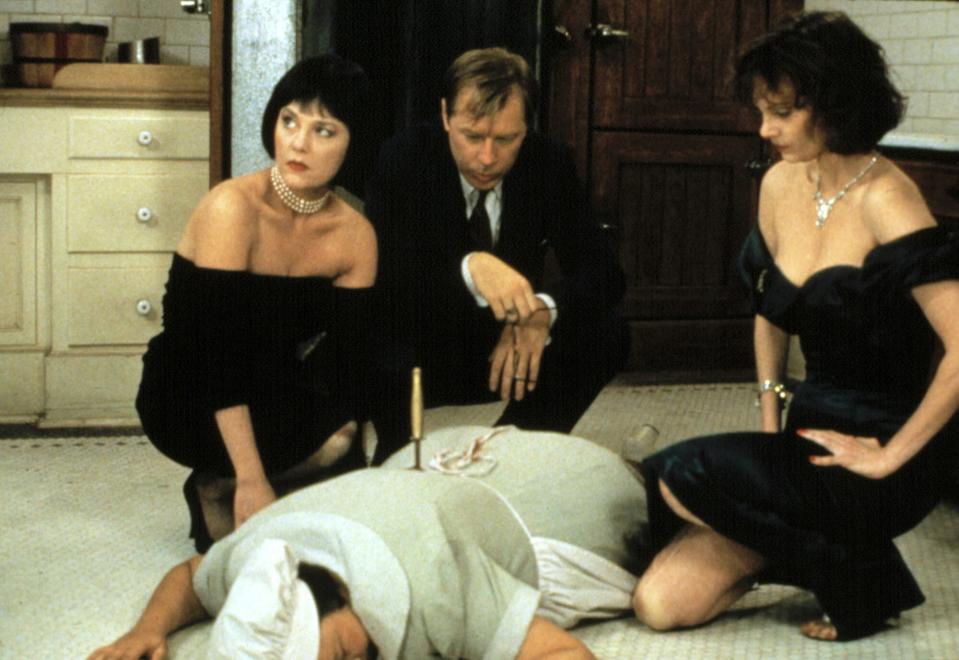
Everett Collection Madeline Kahn, Michael McKean, Kellye Nakahara, and Lesley Ann Warren in 'Clue'
Another murder occurs and the guests find the Cook (Kellye Nakahara) dead in the freezer, as she falls out into Mr. Green's arms with a knife in her back. With a murderer afoot, the group decides to pair off and search the rest of the house for any potential intruders. The sequence is rife with physical comedy, as Colonel Mustard falls through a wall into a secret passageway where he is pushed up against Miss Scarlet, Mr. Green and Yvette are smushed together in a stairwell, and as things escalate ,Mr. Green, Mrs. White, Yvette, and Wadsworth all collide on the stairs.
CAMP: There's just a natural feeling when you're doing comedy of what physicality is funny. And there was something very funny about being jammed into a stairwell. I used the tightness of the stairwell, and the blocking created a natural feeling of being squeezed.
WARREN: When Martin and I did that scene where we're assigned to each other and we're both trying to get out of the door at the same time, that just happened. Knowing the comedy in the moment and her attitude of don't f—ing touch me. We did it several times and deepened it or made it more pronounced. I don't know which take they used, but there's a millisecond where I'm laughing. I don't think it's apparent to anyone else, but Martin made me laugh all the time.
MCKEAN: Sorry to burst your bubble, but the collision on the stairs is all stunt people. Everything else we did ourselves though.
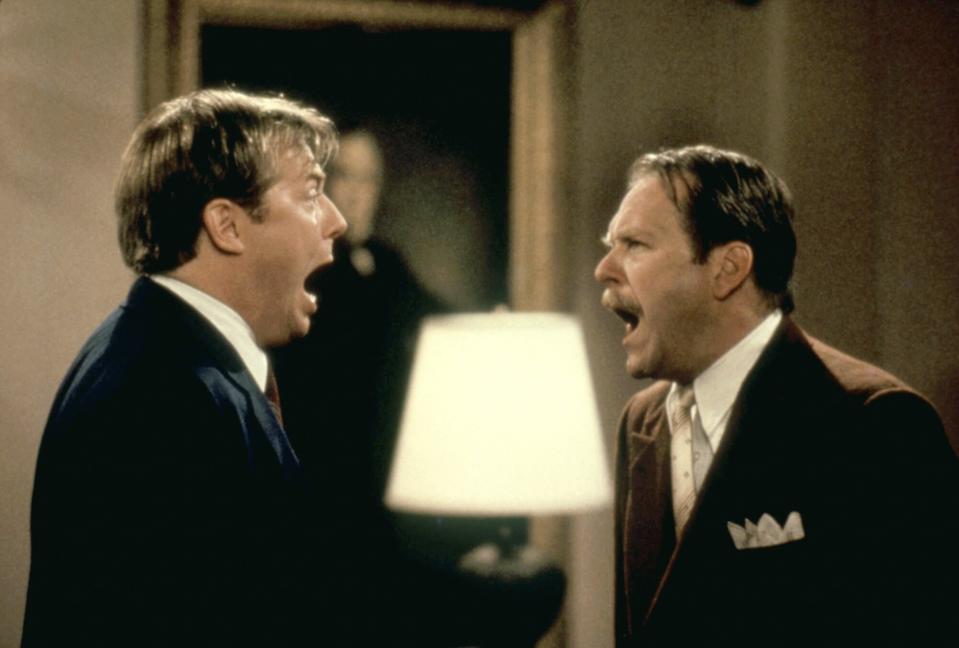
Everett Collection Michael McKean and Martin Mull in 'Clue'
Things begin to escalate as a mysterious motorist arrives, then a cop. The ensemble tries to cover up the murders of Mr. Boddy and the Cook by making it seem as if they're all necking, with Mrs. White making out with Mr. Boddy's corpse, Mustard and Peacock manipulating the Cook's body, and Miss Scarlet and Professor Plum selling it by making out for real.
WARREN: When I am deeply connected to the character that I'm playing, the physical choices come out. So when the door slams, I was like, "Oh, she wouldn't just cover it. She would cover it and take a provocative pose." It's not like I make a conscious choice, but I've already been so imbued with the character's traits that it just comes out of me in the moment.
LYNN: I don't know how I got it into my head, but that [make-out scene was my idea]. And I didn't get any pushback from the studio on it.
WARREN: In real life, I'm not an extrovert. But when it comes to a character that is in charge of herself, I will jump in. So, I remember suggesting parts of that with Chris. I was like, "Why don't I do this? Why don't I be on top?" Of course, Jonathan loved it. It wasn't necessarily choreographed but we did discuss it before we did it and figure out how far to go.
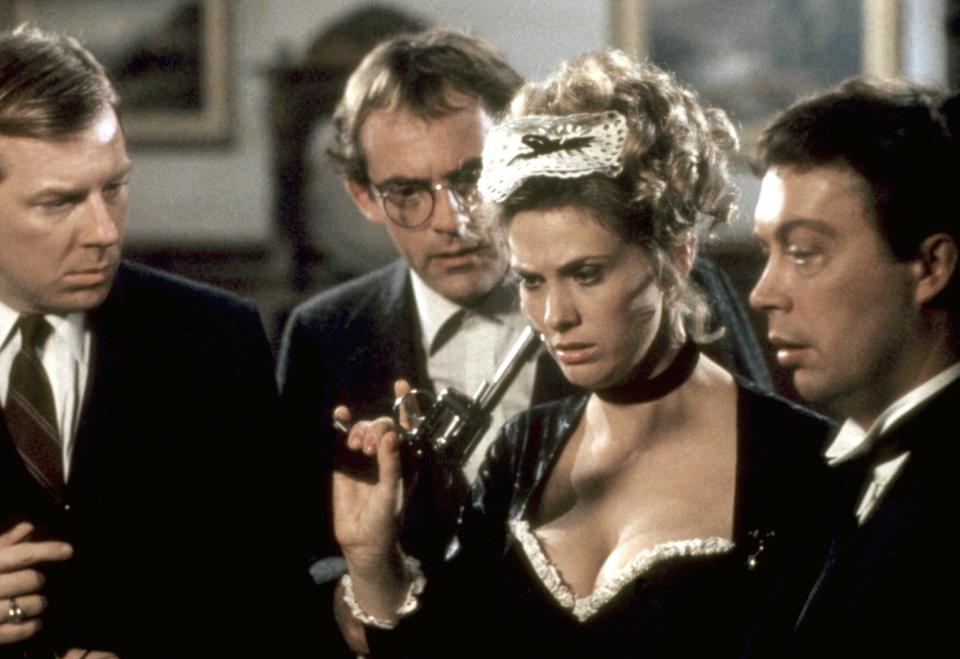
Everett Collection Michael McKean, Christopher Lloyd, Colleen Camp, and Tim Curry in 'Clue'
Another wave of murders occurs. Yvette is strangled with the rope in the billiard room, the motorist is hit with the lead pipe, and a singing telegram girl is shot with the revolver.
LYNN: I got pushback on one shot only, which isn't in the film. When the motorist is killed, we had a big close-up of his face as he fell to the floor, and it had blood on it. They didn't want blood.
CAMP: It was all staged and very mechanical, as is the way in any kind of blocking where there's violence. But you have to actually create the horror of it.
WARREN: Those were all very choreographed. That was more by rote in terms of learning what you're doing, where to put your hands. It didn't have the emotional impact of any of the other scenes because it was very structured.
CAMP: You know exactly how the scene is going to be worked out, so you have to create the ability to be afraid in the moment. It's really trying to create that fear, knowing exactly when someone is going to come up and strangle you and how you're going to move on the pool table.
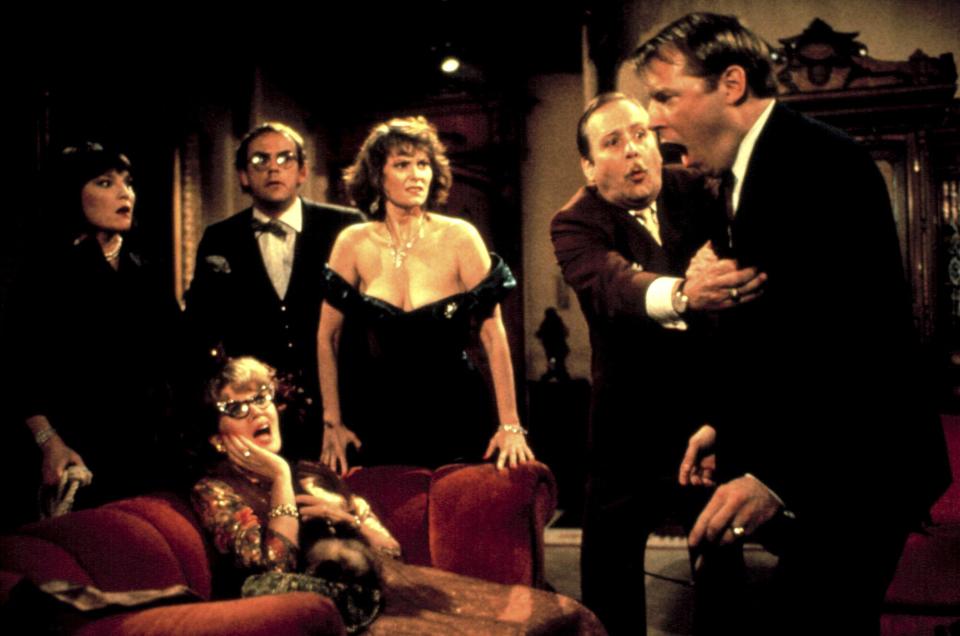
Everett Collection Madeline Kahn, Eileen Brennan, Christopher Lloyd, Lesley Ann Warren, Martin Mull, and Michael McKean in 'Clue'
Wadsworth then launches into a long monologue, running the guests back and forth from room to room as he recaps the events of the evening and tries to piece together who might have committed the murders.
LYNN: It's a very theatrical bit, and Tim is basically talking for about 15 minutes very fast. We couldn't do all that in one take. It would've been impossible because it's in about five or six rooms. He's going backwards and forwards from one room to another. It was shot piece by piece, and I worked it all out in advance.
MCKEAN: We were all glad it wasn't our job. Tim had to say so much. It was a stretch of I'd say two or three days of just Tim taking us through stuff. At one point he was on a skateboard. He goes from one side of the screen to another and glides through while we're all watching him go by. The guy worked for that paycheck, I'm telling you.
LYNN: Michael has a wonderful imagination. Tim was not on a skateboard. I would remember that.
WARREN: Michael Kaplan, the costume designer, had to make two dresses because it was impossible to run in that dress. It was so tight. He made the second dress with this hidden zipper that I could undo when it was these running sequences.
MCKEAN: When Tim was throwing me around through explaining what happened, a lot of those bits developed on the stage. He throws me in the bathroom, and I come out of the bathroom having washed my hands. We threw that in.
WARREN: I was in awe of Tim. The amount of dialogue — and confusing dialogue and repetitive dialogue for comedy's sake — and the speed at which he had to speak at, I was blown away every time. And he was meticulous and perfect every time. Not a lot of people can do that, no matter how talented they are. That's a particular facility that he had that was gorgeous to watch.
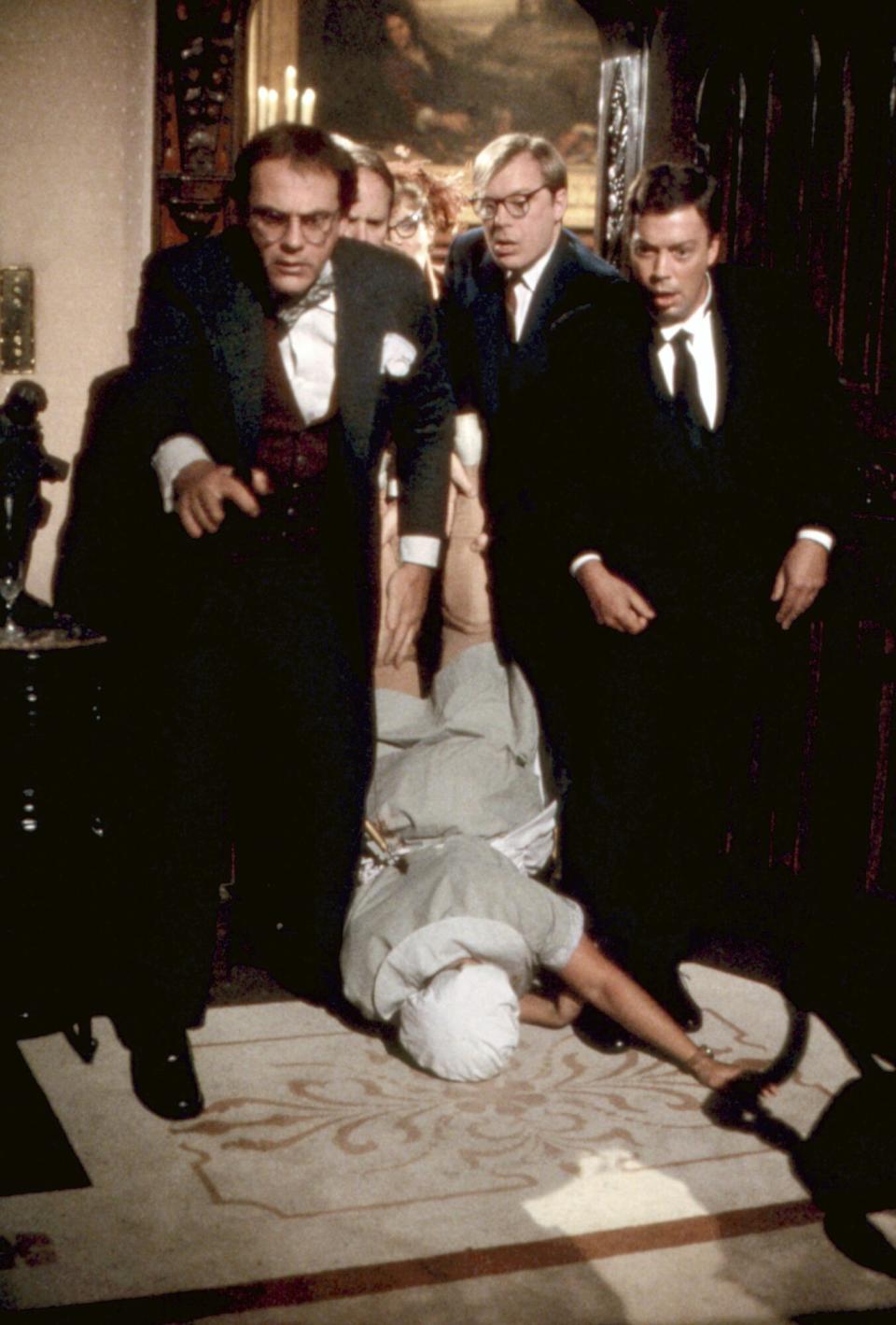
Everett Collection Christopher Lloyd, Michael McKean, and Tim Curry in 'Clue'
As Wadsworth nears the end of his explanation, he offers up a possible conclusion. But the studio wanted multiple, alternate endings. (Theaters would label showings as Clue A, B, or C, and audiences would see one of the three possible endings.)
LYNN: The game always finishes in a different way and they wanted it to be very true to the board game in some way. I had the board on my desk, and I tried to work out who would be where and who could be the murderer. It was very complicated because everything that I shot had to be susceptible to being logically correct for the four endings that were asked for by the studio. That meant that every version of the scene, I had to be very careful who was in it, and more importantly, who was absent from it because they could have been committing a murder at that moment.
WARREN: I didn't know that were we going to do that until somewhere toward the middle or end of shooting.
CAMP: We were on the lot for three months, but I had no idea about the other alternate endings. I found out about that at the very end because they left pages out of the script.
MCKEAN: The first version of the script that I saw had all of them in it.
The fourth ending was ultimately cut from the film.
LYNN: I cut it when we were doing the first edit of the film, and I don't remember what was in it. But I cut it because it either wasn't interesting, surprising, or funny enough.
MCKEAN: One person killed the fake Mr. Boddy. One person killed Yvette, one killed the cop, one killed the motorist, one killed the Western Union girl. It was like all overlapping guiltiness but we weren't in cahoots. It was a contrivance. And it wanted to be a Looney Tunes ending with the bad guys being chased out of the house by dogs.
WARREN: I have zero memory of that.
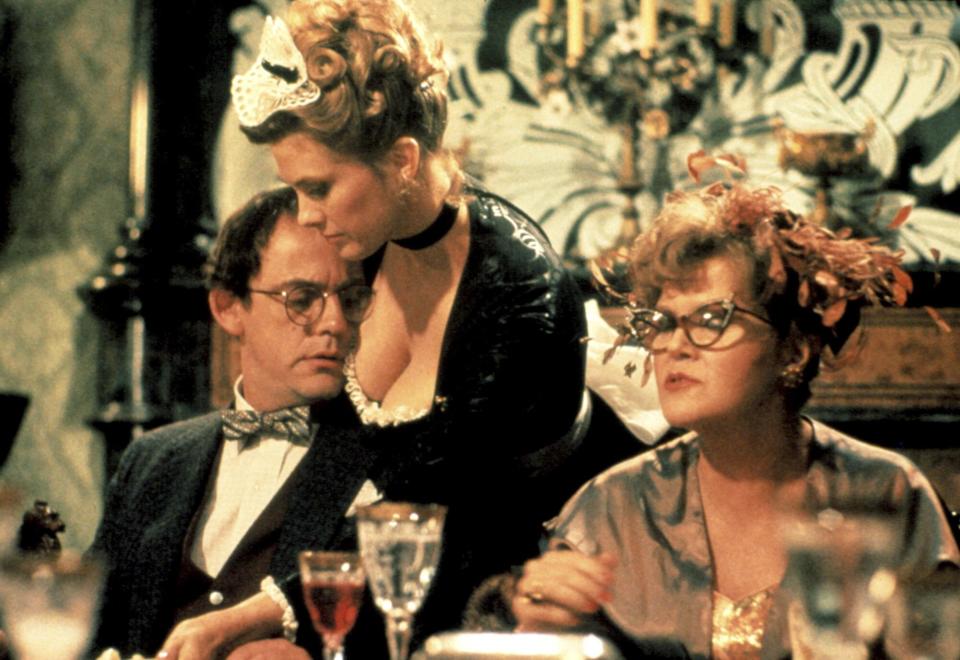
Everett Collection Christopher Lloyd, Colleen Camp, and Eileen Brennan in 'Clue'
The first ending, "How It Might Have Happened," fingers Yvette for murdering Mr. Boddy and the Cook on the orders of Miss Scarlet. Miss Scarlet then kills Yvette, the motorist, and the telegram girl with the intention of selling everyone's secrets. She and Wadsworth face off, arguing over how many bullets are left in the revolver.
WARREN: I wasn't told that I would be the one that would be the villain in my ending. So it wasn't so thought out and so constructed and pre-choreographed, which gave it an excitement in the shooting of it as well.
CAMP: It was so much fun because I'm not some little shady French maid, I'm a mastermind. There's something very fulfilling about being something that somebody doesn't expect.
WARREN: It was fun to be the gun moll and also play her confusion, jumping between that and "I'm in charge. Don't f— with me." And Tim was such a great person to play it with. It's my favorite of the three endings, of course. The counting of the bullets and the bedlam, it's really funny.
Telling Miss Scarlet he "doesn't give a damn," Wadsworth shoots the gun to prove there are no bullets left. He's proven wrong when a bullet hits the rope holding up the chandelier, and it hits the ground narrowly missing Colonel Mustard.
LYNN: You've got a character called Scarlet. That joke becomes essential.
WARREN: I didn't talk about [the fact that I played Scarlett O'Hara on stage in a musical adaptation of Gone With the Wind sequel Scarlett] with anybody, but it certainly tickled me.
LYNN: The only thing we storyboarded was the chandelier falling, and I was too safety conscious. It fell too far from Martin in my view. But I was very safety conscious because producer John Landis had just had a terrible accident on the set of The Twilight Zone. [Editor's Note: Actor Vic Morrow was decapitated and two child actors died during an on-set accident involving a helicopter]. It would've been the worst thing in the world for John if there'd been an accident on another film he was connected with. So, I erred too much on the side of safety and the chandelier should have fallen closer to the actors.
The second ending, "How About This?", names Mrs. Peacock as the murderer of all the victims. Then, the third, "Here's What Really Happened," takes the most surprising approach with each of the guests responsible for a murder, except for Mr. Green, who is an undercover FBI agent. As part of the revelations, Mrs. White utters a now infinitely meme-able speech about hating Yvette and the "f-f-flames" on the side of her face.
LYNN: Madeline Kahn was wonderfully crazy. She was very inventive in the way she played her character. She came to me before we did the shot and said, "Do you mind if I improv something here?" I said, "Not at all, but I still want to shoot what's in the script just in case."
WARREN: We were laughing our heads off. It was priceless. Her delivery is so unique, and I don't know anybody else that has her particular quality and comedic delivery. I've always said this group of actors were some of the very best comedic actors, and that's what made it so special.
CAMP: Everyone applauded. She was beyond brilliant.
MCKEAN: What you're seeing is the second pass. The first one is the same and hysterically funny, but we all just lost it and she broke too, I think. In take two, we were prepared. It was supposed to be just, "Yes, I hated her." That was the whole line. But she went off on this thing about the flames.
LYNN: It made me laugh so much that I didn't bother to shoot the lines we had in the script.
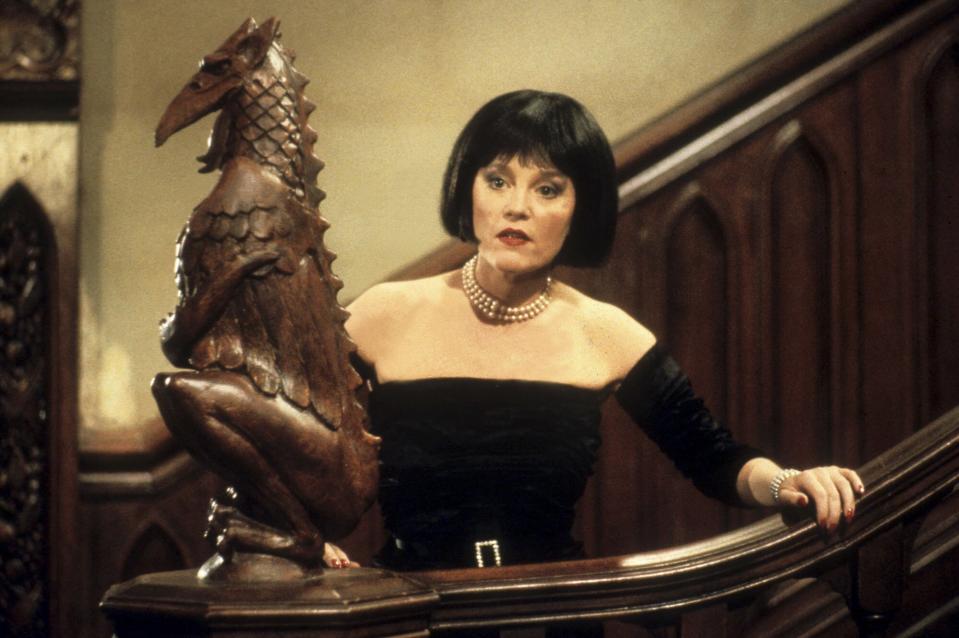
Everett Collection Madeline Kahn in 'Clue'
As he reveals the truth about his identity, Mr. Green tells the chief of police, "They all did it. They killed Mr. Boddy in the hall with the revolver" in the classic cadence of the Clue board game. Then, he announces, "I'm going to go home and sleep with my wife," in contrast to his assumed identity as a gay man.
MCKEAN: The last line of the picture was mine. Jonathan liked it, and he kept it in.
LYNN: I don't think he's right. I remember writing that.
MCKEAN: We were running it before they started lighting it, and I threw it in. I thought it was funny. It might've been replacing something. "Take them away," or something like that. I don't remember the nuts and bolts, but I said it and it made Jonathan laugh. Everybody thought it was funny. So, it went in.
LYNN (following up via email): I checked my script and the last line is in it. However, it's possible that this script was revised after rehearsals and before shooting... so Michael might have improv'ed it in rehearsal.
Released on Dec. 13, 1985, the film didn't recoup its budget and was met with mixed reviews. Jonathan Lynn and the cast always chalked up the lackluster box office performance to the gimmick of the multiple endings.
LYNN: I had great misgivings about the multiple endings. I wouldn't have gone along with it if it hadn't been my first film, but I thought the studio knew what they were doing.
WARREN: It didn't do the movie any justice. It confused people. It was an interesting idea, but it didn't add anything.
CAMP: Because they showed the movie with different endings in different theaters, nobody saw it. They didn't understand why there were different endings and weren't up for going to see all of them.
LYNN: There was this hope that people would see the film with one ending and love it so much they would go and see it with two more endings. But people saw there were multiple endings and didn't know which one to see, so they didn't go at all.
MCKEAN: People looked at it and said, "I don't want to see a movie three times. Especially if I'm going to get the same one again." It was a victim of its gimmick.
LYNN: There was massive confusion. Some of the critics were shown different endings. It was a true mess. Which is why no one has ever done it since.
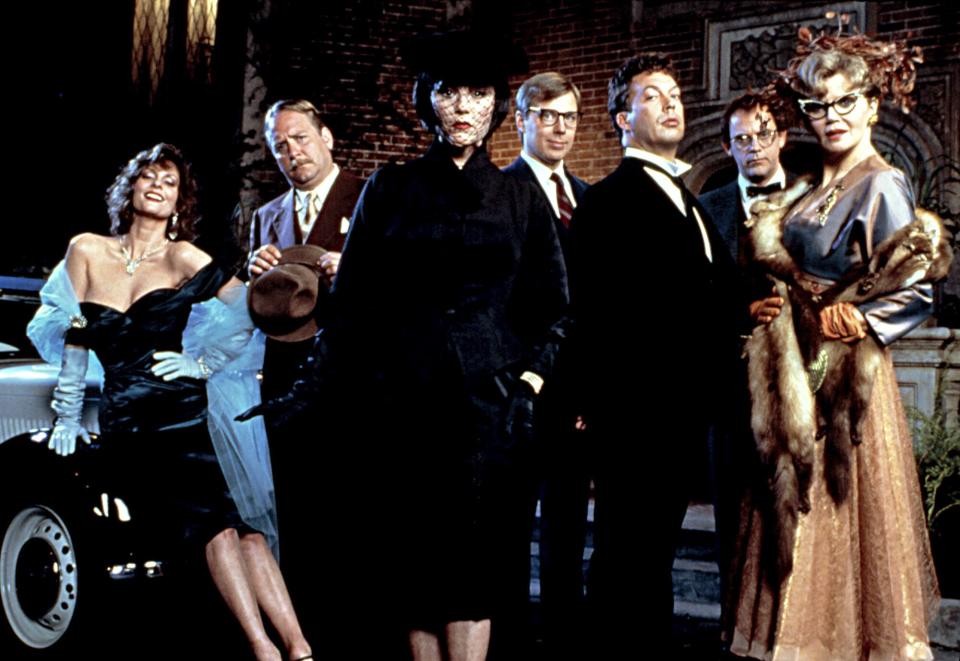
Everett Collection Lesley Ann Warren, Martin Mull, Madeline Kahn, Michael McKean, Tim Curry, Christopher Lloyd, and Eileen Brennan in 'Clue'
Despite its box office disappointments, Clue was released on home video in 1986 with all three endings strung together sequentially. In the years since, it has risen to the status of a cult classic, with fans regularly reaching out to Lynn and the cast about their love of the film.
LYNN: After the film came out and when the video was being prepared, I insisted that all three endings were in the print. I think that's why it suddenly started to go well when people saw it on television. Because you only really enjoy the endings when you see them all together.
CAMP: I loved the different endings. They were trying to create a fun thing like the game where different people were the answer.
MCKEAN: If you try and make too much sense out of the this movie, you're not going to have any fun. The weirdness of it is kind of its point.
LYNN: I edited the endings very slightly, so they would all be different from each other, and I wrote those title cards of "Here's What Really Happened" and so forth. Unfortunately, the line about "communism was just a red herring" somehow managed to stay in all three endings. It was supposed to only be in one of the versions, but when it was all put together, that line remained in all three, which slightly bothers me. But apparently people like it.
MCKEAN: I thought it was good that they repeated it in the way it was assembled. It's like we're in an alternate universe with each ending, but we bolt it down with facts and a couple of jokes.
WARREN: It's so amazing that this opened just okay, and now I get mail from people ages 6 to 75. People come up to me and recite my lines to me. Things I don't even remember.
MCKEAN: The release stuff is irrelevant now because for almost 40 years people have really loved the movie. And we're all really proud of it.
LYNN: The last thing I would've expected was that it would be a failure when it opened and an increasing success over the next four decades. Who would imagine that?
Related content:

